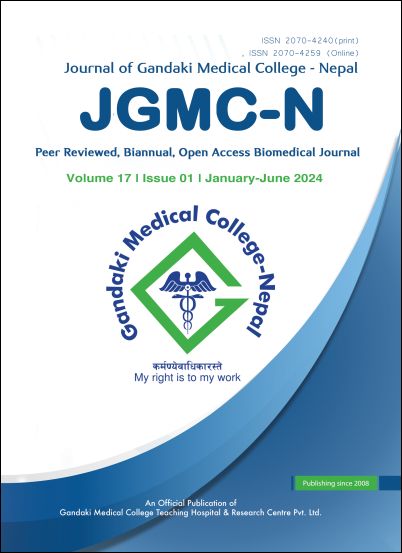Assessment of pattern of mandibular third molar impaction and its associated clinical symptoms in patients visiting tertiary center in Gandaki Province
DOI:
https://doi.org/10.3126/jgmcn.v17i1.66253Keywords:
Impacted third molars, Pell and Gregory classification, Winter’s angulation, symptomsAbstract
Introduction: Mandibular third molars show the highest rate of impaction. Eruption status, position, and angulation
are associated with different symptoms. Thus, this study was conducted to assess the mandibular third molar impaction
pattern and associated symptoms.
Methods: A cross-sectional study was conducted on 426 patients visiting a tertiary center in Gandaki Province. Data collection was done from September 2023 to April 2024. Intraoral examination and orthopantamogram were assessed. The impaction depth and ramus relation of lower third molars were recorded according to the Pell and Gregory classification. The angulation was documented based on Winter’s classification. The associated symptoms including pain, caries, pericoronitis, swelling, trismus, pus discharge, food lodgement, and halitosis were also noted. The frequency of level, angle, and depth of impaction were calculated. The chi-square test was used to assess the association of angulation of impaction with sex.
Results: The mean age of the subject was 33.77±8.86 (range 19 to 68). The most common angulation of impaction was vertical (35.68%) with Level A (46.47%) depth of impaction and Class I (46.47%) ramus relation. Pain (57.98%), distal caries in the second molar (15.49%), and pericoronitis (14.55%) were found to be the most commonly associated symptoms.
Conclusions: Class I vertical level A impaction was most common impaction in this study. Pain followed by caries in distal aspect of second molar and pericoronitis were the common chief complaint presented by the patients with impacted mandibular molars.
Downloads
Downloads
Published
How to Cite
Issue
Section
License
Copyright (c) 2024 The Author(s)

This work is licensed under a Creative Commons Attribution-NonCommercial 4.0 International License.
This license allows reusers to distribute, remix, adapt, and build upon the material in any medium or format for noncommercial purposes only, and only so long as attribution is given to the creator.




